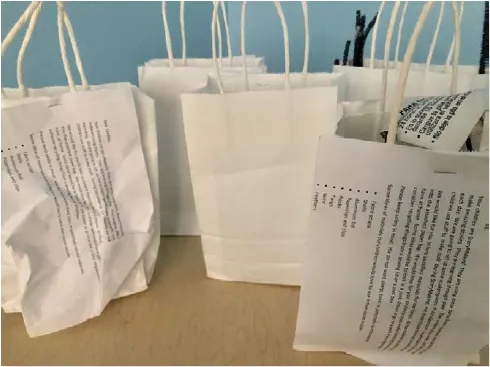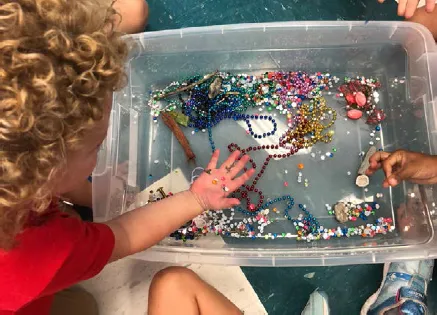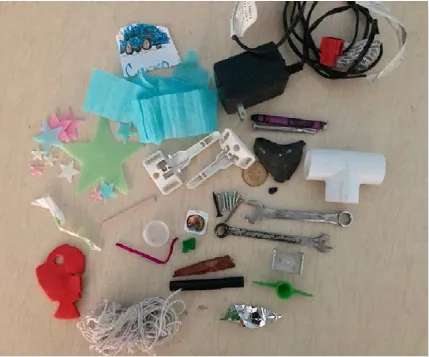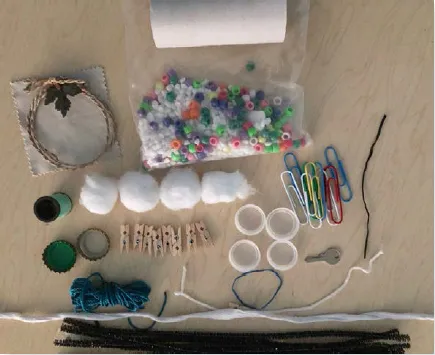![]()
CHAPTER 1
Designing and Setting Up Your Makerspaces
As I explore materials in front of me,
My imagination awakes with possibility.
As a maker, I discover new ways to create.
My materials guide and help me communicate.
Stories to Inspire Making
They looked like plain white paper bags. Nothing special. Some were a bit crumpled, for their adventures had been rough on them. But to the children, they were so much more than plain white bags. They were bags full of secrets-treasure bags, bursting at the seams. The children, imagining magical riches within, couldn’t wait to investigate.
An invitation for children to imagine, play, and make with found materials
Paper bags brought from home, filled with found materials, recyclables, and loose parts
Materials inspire wonder and awe.
Finally, it was time to peek into the bags and discover the jewels, precious metals, and other materials. What wonders did these treasure troves hold?
As more children brought in materials, we moved them to a larger bin.
Everyday objects became magical to children as they scavenged through the loot: shiny parade beads of every color and sticks and broken necklaces with sparkling jewels and shells and screws of all sizes. Discussions of pirates and mermaids and underwater adventures began immediately. Then everyone gathered around as another bag was emptied into the large, transparent plastic bin. There were shoelaces and pipe cleaners and string and bottle caps and cardboard and paper clips and twine and rocks and straws. Each child was invited to fill a container and take it to their table to play, explore, sort, organize, stack, dump, and make.
Children exploring, tinkering, hacking, and repurposing materials brought from home
Each child placed their treasures on a metallic cookie sheet that further reflected their precious bits and pieces. They played and cut and touched and sorted and traded and arranged and talked about their favorites. They made swing sets at the park, built trucks, went on pretend journeys with their materials, and shared their adventures with their friends. They were awed by the materials and their worlds. The materials had conveyed to them that they were going to make wonderful discoveries together.
Each picture captures the contents of one of the treasure bags.
This was the beginning of a wonderful adventure with materials. The children imagined, played, made, and shared the stories, ideas, projects, and thinking that were inspired by the materials they had gathered, collected, brought from home, explored, questioned, investigated, and organized. At the close of the adventure, the materials found homes in containers in each of the makerspaces.
We introduce each chapter with children’s interactions with materials because we have found that the “desire to construct meaning with visual materials is often inspired by the materials themselves. Beautiful, interesting, and appealing materials call out to be touched, used, and played with” (Massey 2017, 7). This introduction, focused on how materials lead to discovery and learning, launches the makerspace highlighted in the chapter. This first story featured excitement about the materials our students and families gathered and brought to the classroom at the beginning of the year.
Why Create Multiple Makerspaces?
Just as you probably have multiple centers, STEM challenge areas, or play spaces in your current learning space, we suggest that you design and set up multiple makerspaces in your current spaces with materials you already have on hand. Not to worry: we will provide inspirations along the way.
You will transform one space at a time, using what you already have. By transforming your current areas into makerspaces, you are simply adding intention and purpose to your play areas. Using the space you already have, the inspirations—ideas, examples, lessons, questions, children’s book recommendations—in this book, and simple materials that you probably already have, you will spark children’s curiosity, invite them to notice and pay attention to their environments, inspire them to think across domains, encourage social-emotional learning, and celebrate as they share and collaborate, building a maker mindset.
Remaking Classroom Spaces into Makerspaces
In this section we offer examples of how you can transform your existing spaces into the makerspace featured in each chapter. Follow these steps to get started:
• Select an area to transform. Do you want to transform an area that your children do not use often? A space that your children love? A new space?
• How many children do you anticipate playing and making in that space? This will determine what materials and space you will need.
• Inspiration and Support: Select a children’s book and create a question that matches your purpose for the makerspace.
• Main Materials: Take an inventory of the main materials you have on hand and select one or two to place in the space at first. Consider removing, storing, or reorganizing items that can be introduced as a new main material later in the year to sustain play and interest.
• Loose Parts: Consider the loose parts you have and choose one to three to incorporate into the children’s playing and making at first.
• Tools and Attachments: Select tools, if any, that will support making with the main materials and loose parts.
Ideally your initial makerspace setup will interest the children for several weeks. Over time, or if you see children’s interest waning, add a new or different main material or select a new category of loose parts to replace the current offering. New loose parts spark wonder and curiosity for making. There is no right or wrong. Use whatever you have that aligns with your current unit of study or theme and will instill a sense of wonder in your children.
Organization/ Aesthetics
We organize our main materials and loose parts by-composition. Our categories ...







